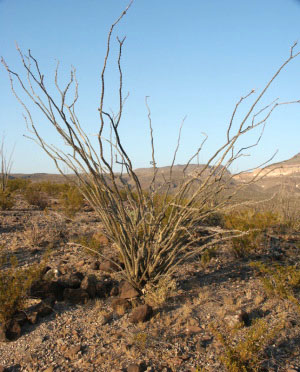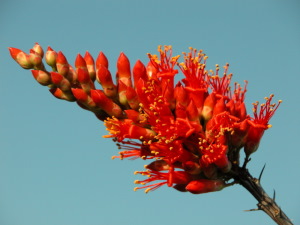Ocotillo, Devil’s Walking Stick
Fouquieria splendens Englem.
Fouquieriaceae (Ocotillo Family)
Ocotillo is an unusual shrub with many slender, spiny, branches that rise from a single stem at ground level. Ocotillo was utilized for the construction of structures and fences, beverages, and medicines. The small leaves clustered in the axils of the spines usually appear only after a rain and soon fall off the plant (Powell 1998). The plant flowers in the spring in terminal clusters of scarlet. Flowering ocotillo presents one of the more picturesque and characteristic viewscapes of the lower Chihuahuan Desert.
Archeology. Ocotillo branches have been recovered from the rockshelters of the eastern Trans-Pecos area (Dering 1979) and identified as part of house construction at several La Junta sites (see La Junta). Although its recovery from other archeological sites elsewhere in the Trans-Pecos has not be documented, very few rockshelters have been excavated in the modern era and it stands to reason that more discoveries will be made.
Food and beverage. The Cahuilla utilized the blossoms in a thirst-quenching drink. They simply soaked them in water (Bean and Saubel 1972). Likewise the Seri sucked the nectar from the flowers (Felger and Moser 1985). The seeds were edible, and the Cahuilla would parch and grind the seeds into a flour to make flat cakes or a mush. Hodgson (2001) notes that locals living in Baja California collected, parched, and ground the seeds into a meal, the consumption of which gave their breath an odd odor. On a sweeter note, the Papago would collect large quantities of flowers, squeeze the nectar out of the blossoms, and allow it to harden into a rock candy which was chewed as a delicacy (Castetter and Underhill 1935). The Seri used ocotillo clubs to collect pelicans, and ocotillo branches to thresh eelgrass (Felger and Moser 1985).
Medicine and personal hygeine, implements, and construction. I have in my library one reference to the medicinal use and a few others to personal hygiene or decoration. The Hualapai soaked their feet in a bath from the roots (Watahomigie 1982). The Papago used the spines to pierce their ears (Castetter and Underhill 1935). Buds, flowers, and dry capsules (the fruit) were fashioned into necklaces by the Seri (Felger and Moser 1985).
Ocotillo, however, was widely utilized in construction, for ocotillo branches are both strong and flexible, and the numerous spines provide anchor points for other material. The Seri used the ocotillo branches as a framework for their rectangular brush house. These were used for temporary camps only, as the wood rots quickly. Felger and Moser (1985) observed that the ocotillo frames would sometimes take root, giving rise to a curious sight of ocotillos growing in a distinctly rectangular pattern. The branches were often used in wattle and daub houses of the Seri, where they would be protected from the elements by the daub. The Papago used the branches as warp in the weaving of house frames. They also used slender young branches to tie house roofing ribs together (Castetter and Underhill 1935). Curtin (1949) reports that the Papago used the branches as fencing which often took root as a living fence. The Pima planted ocotillo to beautify their gardens. In a similar, but more practical application, the Cahuilla made fences from ocotillo branches to keep animals out of their gardens (Bean and Saubel 1972).
References
Bean, Lowell J. and Katherine S. Saubel
1972 Temalpakh: Cahuilla Indian Knowledge and Usage of Plants. Malki Museum Press, Morongo Indian Reservation, Banning, California.
Castetter Edward F. and Ruth Underhill
1935 The Ethnobiology of the Papago Indians. Ethnobiological Studies in the American Southwest. Vol. II, The University of New Mexico Bulletin, Biological Series 4(3). Albuquerque.
Curtin, Leonora S. M.
1949 By the Prophet of the Earth: Ethnobotany of the Pima. [1984 reprint. University of Arizona Press, Tucson.]
Dering, J. Philip
1979 Pollen and Plant Macrofossil Vegetation Record Recovered from Hinds Cave, Val Verde County, Texas. M.S. thesis, Texas A&M University. Published by the Department of Anthropology.
Felger, Richard S. and Mary B. Moser
1985 People of the Desert and Sea. University of Arizona Press, Tucson.
Hodgson, Wendy
2001 Food Plants of the Sonoran Desert. University of Arizona Press, Tucson.
Watahomigie, Lucille J.
1982 Hualapai Ethnobotany. Hualapai Bilingual Program, Peach Springs School District No.8. Peach Springs, Arizona.


